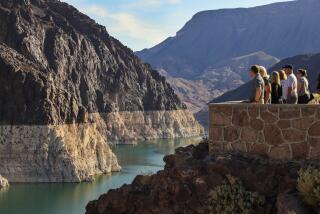What Drought? : Theme parks: Millions of visitors to amusement sites this summer wouldn’t guess this is the fourth year of a drought. But parks are taking conservation measures.
- Share via
While most citizens are encouraged to drive dusty cars, let their lawns turn brown and forgo ordering water at restaurants, Southern California’s major theme parks and water slide complexes will be splashing through business as usual this summer.
California enters its fourth drought-ridden summer next month, according to state water officials, but the millions of visitors at Disneyland, Magic Mountain, Knott’s Berry Farm and five other amusement parks won’t have to worry about coming through dry on Splash Mountain, Tidal Wave or Big Foot Rapids.
Theme parks will be the last to feel cutbacks, said Tim Scrove, Metropolitan Water District media representative.
“They are industries,” he said. “They employ a lot of people. In a water-saving situation, the industry and economy are protected at all costs. There will be mandatory residential restrictions before (the) industrial base is infringed upon.”
Annually, the parks draw an estimated 32 million visitors--the majority visiting during the most popular months of June, July and August, said park officials. The major theme and water slide parks employ about 17,000 additional people during the summer months to accommodate the larger number of tourists.
“A theme park is not the first place you would want to cut water,” said Tim Quinn, director of the State Water Project and Conservation Department. “They use it for entertainment purposes.”
Just because parks use a lot of water, however, doesn’t mean that park officials are not conservation-conscious. In separate interviews, spokesmen at all eight parks said they are taking measures to fight the drought.
Water used in rides and on the water slides is treated and recirculated; low-water toilets and special low-flow bathroom faucets have been installed in some park restrooms; landscaping is being geared toward plants that demand less water and park watering systems have been equipped in some cases with moisture sensors so plants are only watered when needed.
“Most amusement parks use water wisely,” Quinn said. “We are not asking them to not use it wisely. Wasteful practices will not be tolerated by residents or amusement parks.”
Sources and Consumption of Water by Theme Parks
An informal Times survey indicates that Disneyland is probably the largest water user of Southern California’s eight major parks, although neither the granddaddy of all theme parks nor Six Flags Magic Mountain would provide specific water consumption information to The Times.
Magic Mountain spokeswoman Courtney Simmons refused to release the park’s water consumption and said that because the size of her park is larger than other Southern California parks, any comparison could be negative.
“We didn’t want our park to look bad,” she said.
Disneyland also refused to release annual water usage figures. However, Disneyland has three times as many guests and--with its new Splash Mountain--12 more water attractions as Knott’s Berry Farm.
It isn’t the size of the park that determines how much water is used, said Ed Thornhill, MWD conservation manager.
“It’s the number of guests,” he said. “You have to think about all they use. Each time one flushes a toilet, that is 4 or 5 gallons.”
Disneyland, which gets water from the Anaheim Public Utilities Department and two wells on park property (and can draw as much from them as the park needs by paying only a replenishment fee to the county), hoses down Main Street and some of the walkways every night.
“We were thinking of putting something in the suggestion box about the water waste, such as maybe washing down every other night,” one veteran employee told The Times on the condition that his name not be used.
In 1989, the park used 292 million gallons for irrigation and 137 million for non-irrigation purposes, said Nira Yamachita, Orange County Water District director.
Anaheim officials refused to divulge how much additional water Disneyland buys from the city, but an Orange County Water District official told The Times that the park paid $3,633 to the county in replenishment fees during the past fiscal year for additional water to be pumped back into Disneyland’s two private wells. The water from their wells is free, according to Yamachita.
Knott’s Berry Farm, which has only two major water rides (the Log Ride and Big Foot Rapids) on its 35 acres, uses more than 200 million gallons annually. Thornhill said Knott’s uses enough water each year to “meet the entire household needs of 2,500 people for 12 months . . . enough water to fill the Pasadena Rose Bowl four times.”
Knott’s has its own well from which it pumps 87% of the water used in the park, but park officials also must pay an annual $3,000 replenishment fee ($45 an acre foot) to the Orange County Water District. The county then buys water from the Metropolitan Water District to replace that which Knott’s well has taken out of the ground.
The remaining 13% Knott’s uses comes from the city of Buena Park, which sells about 25.6 million gallons a year to the park for an average fee of $1,500 a month.
Conservation Measures at the Southland Parks
With water parks opening full swing next Saturday and amusement parks preparing for summer crowds with extended hours beginning on Memorial Day the industry is gearing up for another season. A look at each park’s conservation measures and outlook:
Disneyland, California’s largest and busiest theme park with 14.4 million annual visitors, is recirculating water used for attractions, installing low-flow landscape sprinklers and drip irrigation systems.
“All rides will operate as normal, we have no plans to close any rides. It hasn’t even been discussed,” said Bob Roth, Disneyland’s spokesman. “We have an ongoing water conservation program but if someone calls for action to be taken we would certainly cut back. However, we want to accommodate without infringing upon our guests.”
The 260-acre Six Flags Magic Mountain in Valencia, which recently unveiled its Viper roller coaster, designed the new attraction’s landscaping in a desert theme with gravel and water-hoarding plants.
As the park heads into its 19th season, park officials predict this to be their busiest summer in park history. They estimated last year’s annual attendance at 3.1 million.
Knott’s Berry Farm serves 5 million guests annually and proclaims that its own well makes it “almost self-sufficient,” according to spokesman Bob Deuel
Knott’s has no plans to reduce the water it uses in landscaping--about 50% of all the water the park uses, Deuel said.
Universal Studios Hollywood used 26 million gallons and is ranked 18th in the Department of Water and Power’s list of the top 250 users.
Universal Studios reduced water consumption by 1% in 1989 (compared to 1988 figures), even after the addition of the new ride, “Earthquake--The Big One,” said Department of Water and Power spokesman Ed Frevdenberg.
The 420-acre theme park has ambitious plans to achieve a 20% cutback in water use this year. Water conservation methods to go into effect today include the installation of a water conservation hot line for employees to report water waste. The trams will be washed less with water and more with dry towels and compressed air.
The studios will also cut washdowns of the park from nightly to three times a week.
At Wild Rivers in Irvine, landscaping has been cut by half and a $200,000 enclosure built on the “Wipe Out” water slide, eliminated “phenomenal waste” and reduced water use by at least one third, according to general manager Greg Briggs.
Briggs said the slide was originally designed to shoot 200 or 300 gallons of water down in about 3 seconds, carrying the rider 250 feet to the bottom of the slide.
“We were very concerned (at the water waste) so we decided to enclose it ,” he said, “We assume there will be some public scrutiny of how we use our water this year.”
Briggs said of the reduced greenery at the water park, “It won’t be as pretty around here, but we will be saving water.” Briggs said the park spends “about $23,000 for water for the five months we are operating, May through December.”
Kent LaMasters, general manager of Raging Waters in San Dimas, the 44-acre water park, said he estimates water usage at approximately 1 million gallons a year. “We at Raging Waters do not use a lot of water on landscaping because we have switched to more concrete and sand,” he said.
Monsoon Lagoon, the 5-acre water park in Redondo Beach, uses 400,000 gallons for the 100 days of operation, Belinda Derme, marketing director said. The park reports that watering the three acres of landscaping is done only in the early morning and late evening.
The park features four fiberglass slide fumes, designed to prevent seepage and splash. One of them, the “Big Splash River Ride,” a river of water that carries more than 840 inner-tube riders an hour down the steep slide, uses 3,500 gallons of water.
Oasis Water Park in Palm Springs, serving 250,000 guests a year, purchases 11 million gallons a year to maintain the pools and 9 water slides.
According to Scrove, this is enough water to serve about 70 homes for a year.
Roger Garrett, president of the park, said the large amount of water needed to constantly refill the pools could be attributed to the average desert humidity of 12%.
WATER AND THE AMUSEMENT PARKS
Attendance Water Rides Acreage Annual Gals. Disneyland 14.4 Million 14 80 Won’t Reveal Knott’s 5 Million 2 35 200 Million Magic Mountain 3.1 Million 6 111 Won’t Reveal Universal Studios 5.1 Million 4 420 26 Million Oasis Water Park 250,000 9 12 11 Million Raging Waters 525,000 25 44 1.4 Million Wild Rivers 400,000 40 20 1 Million Monsoon Lagoon 100,000 4 3 400,000
Queen Mary/Spruce Goose and San Diego Wild Animal Park have no water rides. Sea World uses sea water for its exhibits. Compiled by Deborah Sakamoto
More to Read
Sign up for Essential California
The most important California stories and recommendations in your inbox every morning.
You may occasionally receive promotional content from the Los Angeles Times.









